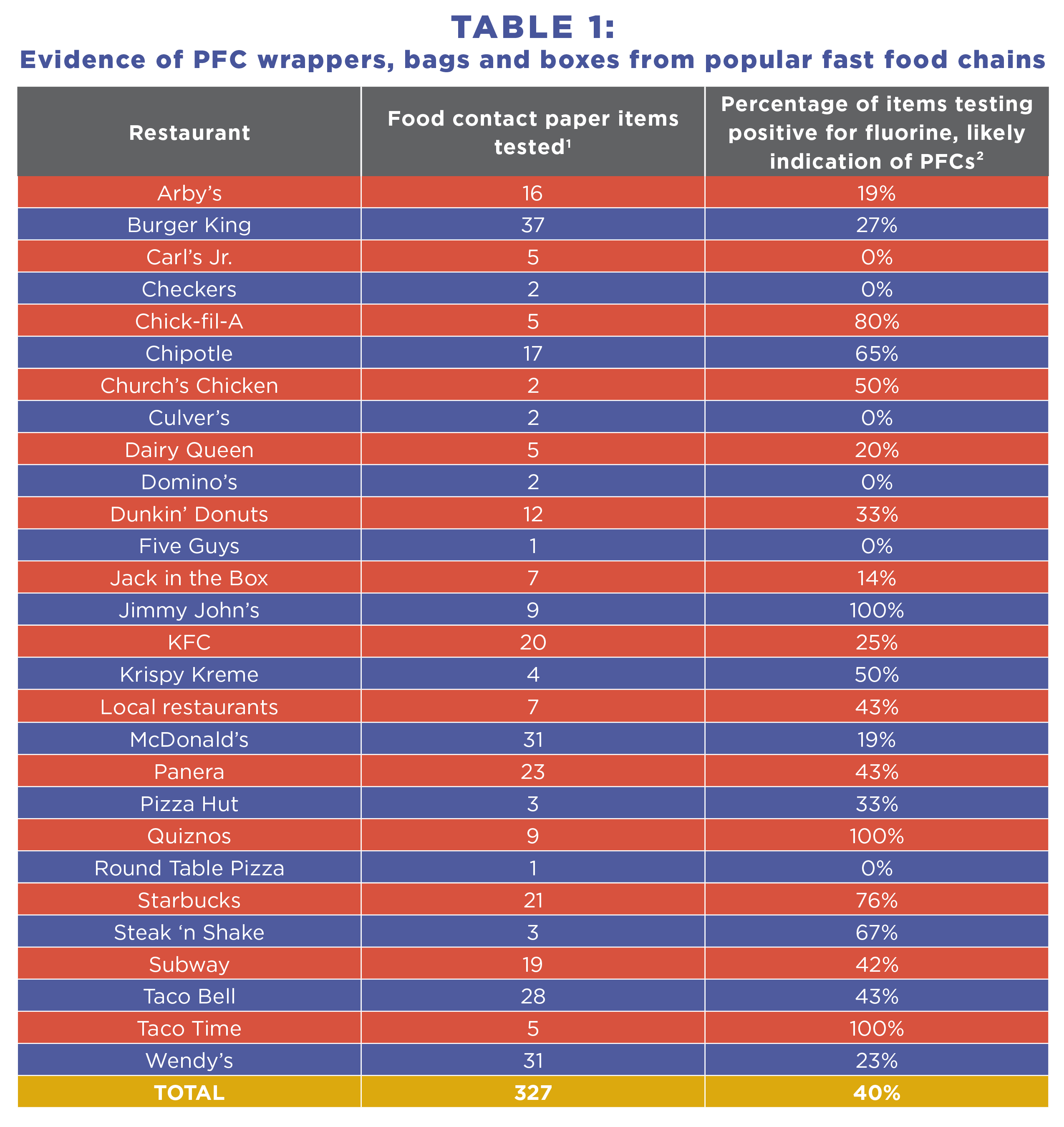While you may enjoy the time-saving benefits of a fast food meal on occasion, you may get more than you bargained for with the food packaging, as you won’t see fluorinated chemicals (PFCs) listed anywhere on the menu.
What are PFC’s?
PFCs are a group of chemicals commonly used to make water, grease and stain repellent coatings. They are per or poly-fluorochemicals used on products such as food packaging, carpets, furniture, clothing, and cookware to give it water resistant, stain resistant or nonstick coating. These chemicals are also linked to numerous health concerns including, but not limited to; increased LDL cholesterol levels, fertility problems, cancer and thyroid disease.
Fast food packaging toxin results
It’s been more than a decade since the health hazards of perfluorinated chemicals, or PFCs, became known, yet they are still commonly used in fast food chains.
Food packaging such as boxes and wrappers for sandwiches or tacos contain this synthetic coating to prevent them from becoming greasy. Per- and polyfluoroalkyl substances (PFASs) are extremely persistent in the environment. They have also built up in the bodies of people and wildlife worldwide. The CDC (Centers for Disease Control and Prevention) have found PFCs in the blood of virtually all Americans. (1)
So what percentage of food packaging contained fluorine?
In one of the most comprehensive studies to date on fluorinated chemicals in food packaging in the U.S., researchers tested over 400 samples from 27 fast food restaurant chains. They tested drink containers, paper wrappers and paperboard for PFASs (per and polyfluoroalkyl substances), also known as PFCs. Scientists found fluorine in about 40% of the samples.
A section of the samples was also tested for PFOAs, 20 percent of the subsection tested positive for this chemical, a synthetic that was previously used to make Teflon.

Photo credit: Environmental Science & Technology Letters: Fluorinated Compounds in U.S. Fast Food Packaging
How do these chemicals get into the body?
These chemicals are absorbed into the body through a variety of methods. Eating foods that are contaminated with these chemicals is a major cause of exposure. Additional causes include VOCs from carpeting, clothing (specifically clothes that are water or stain resistant), air, water and dust from furniture that has been chemically treated for stain or water resistance.
Eating high quantities of fish can also contribute to higher exposure levels.

Source: EWG, from L. Schaider et al., Fluorinated Compounds in U.S. Fast Food Packaging. Environmental Science and Technology Letters, February 2017.
PFCs, PFASs, PFOSs and PFOAs and their impact on your health
Common ingredients used in packaging such as PFOS, PFOA are some of the most researched. These chemicals are linked to higher cholesterol levels, decreased immune response in children, fertility problems, adverse developmental effects, kidney and testicular cancer, thyroid problems and reduced hormone function.
A number of studies have also reported PFAAs detected in plasma, breast milk, liver, seminal plasma, and umbilical cord blood
Cancer – Pub Med has over 1,800 studies regarding PFOAs. There are 83 studies regarding the specific connection between cancer and PFOAs. PFOAs are also linked to high toxicity levels and tumors in at least four different organs in animal tests (liver, mammary glands, pancreas, and testicles).
Increased LDL cholesterol levels – This study from the Archives of Pediatric & Adolescent Medicine showed that children and teens with higher PFOA levels had higher levels of total cholesterol and LDL or “bad” cholesterol.
Infertility – This study found that PFOA and PFOS dramatically increase the odds of infertility. A 2009 study shows that PFOS increased the risk of infertility from 70 to 134 percent, while PFOA was linked to a 60 to 154 percent increased risk of infertility.
Immune system problems — PFCs have an adverse effect on your immune system. This EWG report on PFCs and PFOA also shows the decrease in the body’s ability to fight infection, as well as the increased risk of thyroid damage (this hormone is critical for proper growth and development in children) higher cholesterol levels and liver damage.
Thyroid disease – This Environmental Health Perspectives study found that high concentrations of PFOA and PFOS can damage thyroid function and is linked with current thyroid disease in the U.S.
Why aren’t we using fluorine-free paper?
Grease-resistant food-contact paper and paperboard that is not contaminated with PFCs and other fluorinated chemicals have been available for the past ten years. Ask your local fast food restaurant to make the switch, or tell them why you are boycotting them, till the change is made.
Three companies that make fluorine-free paper
Twin Rivers Paper Company of Madawaska, Maine
Akzo Nobel of the Netherlands
Imerys, a French multinational

Ten tips for avoiding PFCs
With modern convenience, comes the increased risk of toxin exposure. While it is impossible to avoid all toxins, you can limit or minimize your exposure risk by making conscious choices in your daily life.
- Pack your own lunch at home. You’ll know the freshness of the foods and the ingredients used. You’ll also save time and money by making it yourself.
- Use stainless steel boxes, or glass storage containers to pack your meals.
- Drink pure, clean filtered water.
- Eat mostly fresh organic whole foods. Processed, pre-made and packaged foods contain higher levels PFCs, phthalates, BPA, and preservatives.
- Store foods at home in glass containers rather than plastic.
- Avoid all nonstick pans and utensils.
- Use glass or stainless steel bottles for your portable drinks.
- Avoid microwave popcorn. These bags are lined with chemicals to prevent oil from soaking through the packaging. When heated, these chemicals leach into the popcorn; when ingested, they show up as blood contaminants.
- Avoid eating foods that are heated in their own packaging.
- Avoid any clothing or outdoor gear that is labeled stain or water repellent.
This article was originally posted at The Hearty Soul







